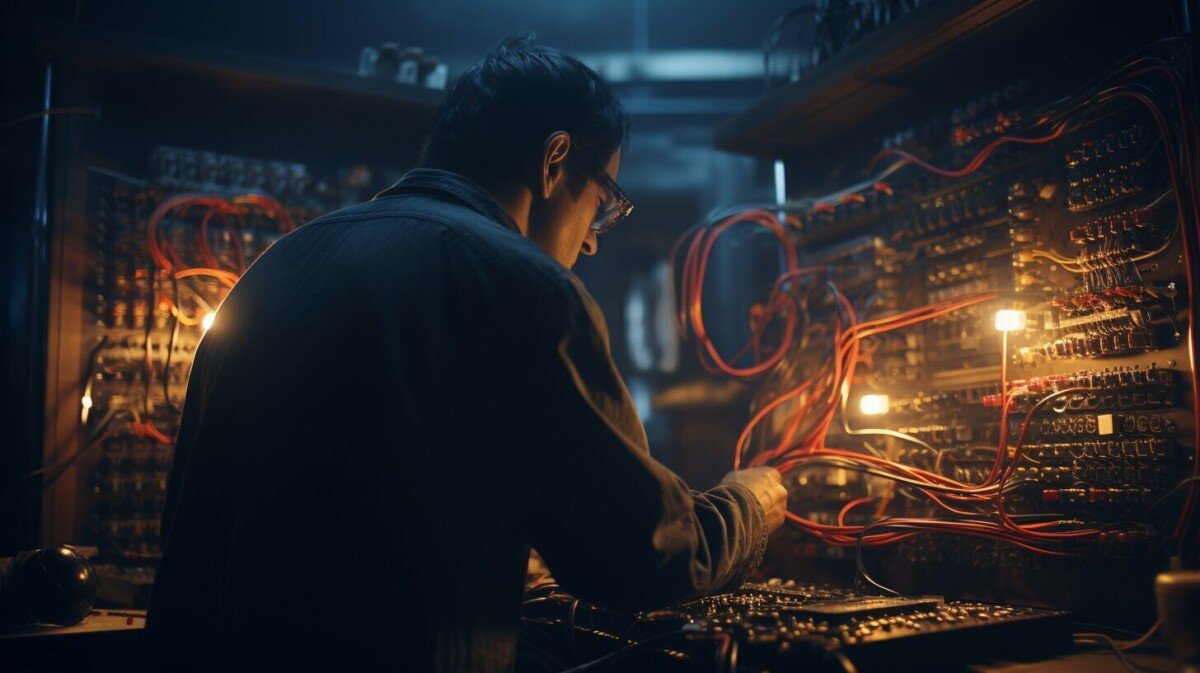Welcome to our comprehensive guide on troubleshooting electrical circuits. Electrical circuits are responsible for powering our homes, offices, and buildings, and they are essential for our day-to-day lives. However, circuit problems can arise from time to time, and it’s crucial to have the knowledge and skills to diagnose and fix these issues to ensure the safe and reliable functioning of electrical systems.
In this section, we will introduce the topic of troubleshooting electrical circuits and provide an overview of the common issues that may arise. We will also discuss the importance of developing good problem-solving skills when dealing with electrical systems. By the end of this section, you will have a better understanding of how to approach troubleshooting circuit issues, and you will be better prepared to tackle any electrical circuit problem that comes your way.
Understanding Basic Electrical Terms and Concepts
Before you can effectively troubleshoot electrical systems, it’s essential to have a solid foundation in the fundamental concepts and terms associated with electrical circuits.
Voltage
Voltage, also known as electric potential difference, is the force that drives an electric current. It is measured in volts (V).
| Symbol | Unit of Measurement |
|---|---|
| V | Volts |
Understanding voltage is crucial in diagnosing electrical problems because it determines how much energy is available to move an electric current through a circuit.
Current
Current is the flow of electric charge through a circuit. It is measured in amperes (A).
| Symbol | Unit of Measurement |
|---|---|
| I | Amperes |
Electric current is essential because it determines how much power a circuit can handle, and improper current flow can cause overheating and damage to circuit components.
Resistance
Resistance is the degree to which a material opposes the flow of electric current through it. It is measured in ohms (Ω).
| Symbol | Unit of Measurement |
|---|---|
| R | Ohms |
Knowing resistance is crucial because it determines the effectiveness of a circuit’s components and helps to ensure they are functioning correctly.
Power
Power is the rate at which work is done, and it is measured in watts (W).
| Symbol | Unit of Measurement |
|---|---|
| P | Watts |
Understanding power is essential in diagnosing electrical problems because it determines how much energy is being transformed in a circuit.
Series and Parallel Circuits
There are two primary types of circuits: series and parallel.
- A series circuit is a circuit in which the components are arranged one after another in a single loop.
- A parallel circuit is a circuit in which the components are arranged in parallel branches, each with its own path for electric current flow.
Understanding the difference between series and parallel circuits is crucial when diagnosing electrical problems because it affects how the circuit behaves and how to test its components.
Tools and Equipment for Troubleshooting Electrical Circuits
When it comes to troubleshooting electrical circuits, having the right tools and equipment is essential. The following are some of the essential diagnostic tools required to test electrical circuits:
| Tool Name | Description |
|---|---|
| Multimeter | A multimeter measures electrical voltage, current, and resistance. It is a versatile tool and can be used in a variety of applications. |
| Circuit Tester | A circuit tester is used to check if a circuit is live or not. It is a simple tool that is easy to use and is an essential part of any toolkit. |
| Voltage Tester | A voltage tester is used to test the presence of voltage in a circuit. It is a useful tool for troubleshooting electrical circuits and can help identify a range of issues. |
| Wire Strippers | Wire strippers are used to remove the insulation from electrical wires. They are an essential tool for working with electrical circuits. |
| Wire Cutters | Wire cutters are used to cut electrical wires. They are designed to cut through different types of wire and are an essential tool for any electrician. |
In addition to these tools, it is a good idea to have a range of different screwdrivers and pliers. These tools can be used to tighten and loosen screws, and to bend and shape wires.
It is essential to ensure that all tools and equipment are in good working order before starting any electrical work. Damaged or faulty tools can be dangerous and can cause electrical shocks or fires.
Safety Precautions for Troubleshooting Electrical Circuits
Working with electrical systems can be dangerous, and it is essential to take the necessary precautions to ensure your safety and the safety of others. Below are some of the safety measures you should follow when troubleshooting electrical circuits.
1. Always Turn Off the Power
Before you begin working on an electrical circuit, it is crucial to turn off the power supply. This means switching off the circuit breaker or unplugging the device. You should also use a voltage tester to verify that the power is off before starting work.
2. Use Personal Protective Equipment (PPE)
Wearing personal protective equipment is critical when working with electrical systems. You should wear safety glasses, insulated gloves, and other protective gear as necessary to ensure your safety.
3. Ground the Circuit
When troubleshooting electrical circuits, it is important to ground the circuit to prevent electrical shocks. You should connect a grounding wire to the circuit or use a grounding strap to discharge any static electricity that may have built up.
4. Avoid Working Alone
It is always wise to work with a partner when troubleshooting electrical circuits. This ensures that someone is available to help in case of an emergency.
5. Keep Work Areas Clean and Tidy
Keeping your work area clean and tidy is essential to prevent accidents and injuries. You should ensure that your work area is clear of clutter and that all tools and equipment are stored correctly when not in use.
Common Electrical Circuit Problems
When troubleshooting electrical circuits, it is important to be aware of common issues that can arise and how to solve them. Here are some of the most common problems:
| Problem | Solution |
|---|---|
| Blown Fuse | Replace the fuse with one that has the same amperage rating. |
| Tripped Circuit Breaker | Reset the circuit breaker by turning it off and then on again. |
| Faulty Switch | Replace the switch with a new one. |
| Loose Connection | Tighten the connection or replace the faulty component. |
| Ground Fault | Identify and repair the damaged insulation or replace the faulty component. |
It is important to note that these are just some of the most common issues and that there could be more complex problems that require a skilled electrician to repair.
Troubleshooting Circuit Breakers
Circuit breakers are designed to protect electrical systems from overloads and short circuits. However, they can sometimes fail, causing electrical problems. Troubleshooting circuit breakers involves a few simple steps that can help identify and fix many issues.
Step 1: Turn off Power
Before troubleshooting circuit breakers, turn off the power to the circuit by switching off the breaker for that circuit. If you are unsure which breaker controls the circuit, turn off the main power switch.
Step 2: Remove the Cover
Remove the cover from the circuit breaker panel to access the breakers. Be careful not to touch any wires or terminals inside the panel.
Step 3: Inspect the Circuit Breaker
Inspect the circuit breaker for any signs of damage or burn marks, or if it appears to be tripped. A tripped breaker will have a switch that is in between the “On” and “Off” positions. If the breaker is damaged, it will need to be replaced by a qualified electrician.
Step 4: Reset the Circuit Breaker
If the circuit breaker is tripped, switch it to the “Off” position, and then back to the “On” position. If it trips again, it may be due to an electrical overload or a short circuit in the circuit.
Step 5: Test the Circuit
Test the circuit to check if it is working correctly using a multimeter tool. Place one lead of the multimeter tool on the “hot” wire and the other lead on the neutral wire. Look for a reading of 120 volts for a standard US circuit.
Step 6: Call an Electrician
If you are unable to troubleshoot the circuit breaker or are unsure of the problem, call a qualified electrician. Handling electrical work without proper training and knowledge can be dangerous and lead to serious injury or damage to the electrical system.
Troubleshooting Electrical Wiring
Electrical wiring issues can be frustrating and dangerous. Faulty wiring can lead to circuit failures, electrical shocks, and even fires. Troubleshooting electrical wiring requires knowledge of electrical systems and specialized tools, but with some patience and attention to detail, you can identify and fix wiring problems.
Techniques for Troubleshooting Electrical Wiring
To troubleshoot electrical wiring problems, there are several techniques you can use.
| Technique | Description |
|---|---|
| Visual Inspection | Start by visually inspecting the wiring for signs of damage, such as fraying, corrosion, or loose connections. |
| Continuity Testing | Use a multimeter to check for continuity in the wiring. This will help you identify breaks in the circuit. |
| Voltage Testing | Use a multimeter to check for voltage in the wiring. This will help you identify if there is a power source and if it is functioning properly. |
Once you have identified the problem, you can take the necessary steps to fix it. This may involve replacing damaged wiring, tightening loose connections, or rerouting wiring to avoid potential hazards.
Tip: When troubleshooting electrical wiring, always take safety precautions, such as turning off the power supply and wearing personal protective equipment.
Electrical Circuit Maintenance
Regular maintenance of electrical circuits is crucial for their reliability and safety. Electrical circuits consist of various components such as wires, switches, and outlets that need to be inspected and maintained regularly to ensure proper functioning. Here are some essential steps involved in maintaining electrical circuits:
- Visual Inspection: Regular visual inspections of electrical circuits can help identify potential issues. Check for any signs of wear and tear, such as frayed wires or loose connections, which can cause electrical problems.
- Cleaning: Dirt and dust can accumulate on electrical components and interfere with their performance. Regular cleaning of switches, outlets, and other electrical components can help improve their performance.
- Tightening connections: Loose connections can cause electrical circuits to malfunction. Regularly check and tighten all electrical connections to ensure proper functioning.
It is essential to hire a licensed electrician for any electrical repairs or maintenance work. Additionally, any repairs or maintenance work should be done only with the power off and using proper safety equipment such as gloves and goggles.
Troubleshooting Electrical Systems in Commercial Buildings
Troubleshooting electrical systems in commercial buildings can be a challenging task due to the complexity of the systems involved. It is essential to have a good knowledge of the electrical systems and the equipment used in commercial buildings to identify and resolve issues. Here are some common electrical circuit issues that can arise in commercial buildings and their solutions.
Tripped Circuit Breakers
Tripped circuit breakers are a common issue in commercial buildings, and they are caused by overloading or short circuits. When a circuit breaker trips, it cuts off power to the connected circuit to prevent damage to the electrical equipment. To resolve this issue, the circuit breaker should be reset by switching it off and then on. If the circuit breaker trips frequently, it may indicate an underlying problem that requires professional attention.
Faulty Wiring
Faulty wiring is another common issue in commercial buildings, and it can cause electrical fires and shocks if left unattended. Visual inspection is an essential tool when troubleshooting electrical wiring, and it is done by examining the wiring for signs of damage or wear and testing the connections for tightness. Continuity testing and voltage testing are also useful in identifying wiring issues.
Malfunctioning Lighting Fixtures
Malfunctioning lighting fixtures are a common issue in commercial buildings, and they can cause inconvenience and reduce productivity. The first step in troubleshooting lighting fixtures is to check the wiring and connections. If the wiring is intact, the issue may be with the fixture itself, and it will require replacement.
In conclusion, troubleshooting electrical systems in commercial buildings requires a good understanding of the electrical systems and equipment involved. It is essential to take the necessary safety precautions when working with electrical systems and to seek professional help when necessary.
Section 10: Frequently Asked Questions (FAQs)
If you’re troubleshooting electrical circuits, you’re likely to have questions. Here are some of the most commonly asked questions about electrical circuit problems:
Q: How can I identify circuit problems?
A: Common signs of electrical circuit problems include flickering lights, tripped circuit breakers, and humming sounds. You can also use a multimeter or circuit tester to identify the problem.
Q: When should I call an electrician?
A: If you are not experienced in troubleshooting electrical circuits, it is usually best to call a licensed electrician. Additionally, if you are experiencing repeated circuit problems or if the problem is beyond your expertise, it’s time to call in a professional.
Q: How can I prevent future electrical issues?
A: Regular maintenance is crucial to preventing future electrical issues. Make sure to clean and tighten all connections, check for loose wiring, and replace faulty components. It’s also a good idea to have your electrical system inspected by a professional every few years.
Q: Can I troubleshoot electrical circuits on my own?
A: If you have experience in electrical circuit troubleshooting, you can certainly attempt to troubleshoot circuits on your own. However, if you are not familiar with electrical systems, it is best to leave the job to a licensed electrician.
Q: How can I ensure my safety while troubleshooting electrical circuits?
A: Always wear personal protective equipment, including safety glasses and gloves. Make sure to ground the circuit and verify that the power is off before starting work. Additionally, it is a good idea to use a non-contact voltage detector to check for live circuits.
Q: What should I do if I encounter a problem that I cannot fix?
A: If you encounter a problem that you cannot fix, it is best to call a licensed electrician. Attempting to fix a problem beyond your expertise can be dangerous and may cause further damage to the electrical system.



